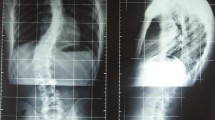Abstract
We retrospectively reviewed six pediatric cases of medial clavicular injury, i.e., epiphyseal separation (Salter/Harris type I or II injury), diagnosed between 1993 and 1997. The clavicular metaphysis was displaced posteriorly in three cases and anteriorly in three. On conventional radiographic views the diagnosis was initially missed in two of three retrosternal dislocations. A special X-ray projection (described by Heinig) or computed tomography (CT) permitted correct diagnosis. Anterior dislocations were immediately and correctly diagnosed. Closed reduction successfully treated retrosternal displacement in two of the three patients. The third patient needed open reduction and internal fixation. Open reduction and internal fixation had to be performed in all three patients with anterior displacement. Follow-up assessment showed perfect functional results in all cases. Direct visualization during open reduction, which was necessary in four of six cases, yielded clear evidence that the so-called sternoclavicular dislocation in children and young adults is, in fact, a fracture of the medial growth plate with posterior or anterior displacement of the metaphysis.



Similar content being viewed by others
References
Curtis RJ, Dameron TB, Rockwood CA (1996) Fractures and dislocations of the shoulder in children. In: Rockwood CA, Wilkins KE, King RE (eds) Fractures in children, 3rd edn. Lippincott, Philadelphia, pp 829–920
Heinig CF (1968) Retrosternal dislocation of the clavicle: early recognition, X-ray diagnosis and management. J Bone Joint Surg (Am) 50:830
Simurda MA (1968) Retrosternal dislocation of the clavicle: a report of four cases and a method of repair. Can J Surg 11:487–490
Alexander CJ (1976) Effect of growth rate on the strength of the growth plate-shaft junction. Skeletal Radiol 1:67
Rang M (1983) Children’s fractures, 2nd edn. Lippincott, Philadelphia, p 141
Yang J, Al-Etani H, Letts M (1996) Diagnosis and treatment of posterior sternoclavicular joint dislocations in children. Am J Orthop 25:565–569
Leighton RK, Buhr AJ, Sinclair AM (1986) Posterior sternoclavicular dislocations. Can J Surg 29:104–106
Cope R (1993) Dislocations of the sternoclavicular joint. Skeletal Radiol 22:233–238
Thomas DP, Davies A, Hoddinott HC (1999) Posterior sternoclavicular dislocations—a diagnosis easily missed. Ann R Coll Surg Engl 81:201–204
Cope R, Riddervold HO, Shore JL, Sistrom CL (1991) Dislocations of the sternoclavicular joint: anatomic basis, etiologies, and radiologic diagnosis. J Orthop Trauma 5:379–384
Asfazadourian H, Kouvalchouk JF (1997) [Retrosternal luxation of the clavicle. Apropos of 4 cases surgically treated using a temporary screwed anterior plate and review of the literature]. Ann Chir Main Memb Super 16(2):152–169
Eskola A (1986) Sternoclavicular dislocation. A plea for open treatment. Acta Orthop Scand 57:227–228
Author information
Authors and Affiliations
Corresponding author
Rights and permissions
About this article
Cite this article
Gobet, R., Meuli, M., Altermatt, S. et al. Medial clavicular epiphysiolysis in children: the so-called sterno-clavicular dislocation. Emergency Radiology 10, 252–255 (2004). https://doi.org/10.1007/s10140-003-0285-4
Received:
Accepted:
Published:
Issue Date:
DOI: https://doi.org/10.1007/s10140-003-0285-4




